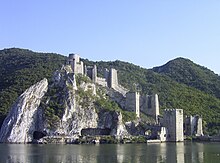Golubac fortress
The fortress Golubac ( Serbian Голубачки Град Golubacki degrees ), also called pigeon city or pigeons castle known is a fortress near the Serbian town of Golubac and the Djerdap National Park . It is one of the most beautiful medieval fortresses on the Danube .
At the place of the fortress there was a Roman fortification called " Columbaria " (= pigeon house). The derived Serbian name Golubački Grad or Golubac means pigeon town or pigeon castle . It is believed that it was built on terraced rocks in the 14th century by Serbian military builders during the reign of King Dušan .
The Golubac fortress consists of a lower and an upper castle. There are eight towers in total, the height of which varies between 20 and 30 meters. The remains of a Serbian Orthodox church in the upper castle testify to the presence of a Serbian lord of the castle, of whom nothing is known.
The well-preserved fortress structures are an attraction for tourists . Some buildings stand directly in the water because the water level of the Danube has risen several meters as a result of the damming. In the immediate vicinity is the Iron Gate , the largest breakthrough valley on the Danube and in Europe between Serbia and Romania .
history
The Golubac fortress has an eventful history. Before it was built, there was a Roman settlement at this point. During the Middle Ages it was the scene of many battles, especially between the Ottoman Empire and the Kingdom of Hungary . The city, with its strategically important location on the banks of the Danube, often changed rulers, was destroyed and rebuilt, and was alternately under Turkish, Bulgarian, Hungarian, Serbian and Austrian rule. In 1867 the Austrians handed them over to Serbia.
Golubac was first mentioned in a Hungarian document in 1335, and a little later in Ottoman chronicles, where it was recorded that the Golubac fortress was in Serbian hands until 1389. In 1391 the fortress and settlement were taken by Sultan Bayezid I , but he could not hold them for long. Then Hungary recaptured the city and fortress under Peter Perényi . In 1403 the Serbian prince Stefan Lazarević got Golubac as a fief from Hungary. After his death, Golubac was to be returned to Hungary. However, the Serbian voivode, Jeremiah, handed the city over to the Ottomans in 1427. In 1444, with the renewal of the Serbian state (the Ottomans occupied Serbia for the first time in 1439), Golubac was again in Serbian possession, only to fall back to the Ottomans in 1456. Hungary conquered Golubac for a short time in 1481, and the Habsburgs held it from 1688 to 1690 and from 1718 to 1739. Thereafter the Ottomans ruled Golubac again until 1867, when they surrendered it and the Belgrade fortress to the then Principality of Serbia after the Serbs were finally liberated from Ottoman rule by the second Serbian uprising .
In 2014, the reconstruction of the castle ruins began. A new tunnel was built and the trunk road that used to run through the lower castle was relocated. Further plans envisage the construction of an open-air stage in a nearby quarry and the construction of a settlement with holiday homes.
architecture
The fortress' irregular ground plan follows the configuration of the terrain.
Web links
- Anton Zollner: Medieval castles of the Banat, the castles "Sankt Ladislaus" and "Golubatsch". 1991.
- Official website, Serbian
- Reconstruction information
Coordinates: 44 ° 39 ′ 38.6 " N , 21 ° 40 ′ 40.5" E

